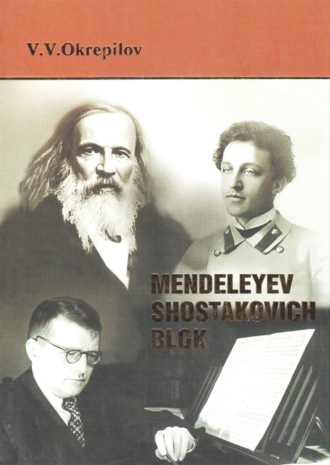
В. В. Окрепилов
Mendeleyev. Shostakovich. Blok
D. I. Mendeleyev is a scientist, a teacher, a public figure
The 1860’s became for Dmitry Ivanovich Mendeleyev the time of realization of the significant research of scientific and applied nature. Here the amazing correlation of theoretical works of the scientist and their practical application became apparent.
Later his son Ivan Dmitrievich Mendeleyev wrote about his father, “I knew as though two Mendeleyevs. One of them was an assiduous collector of facts, a petty empiricist – Wagner of Goethe, for whom the highest pleasure was the treatment of the number, piling of the data, examination of interesting individual features of the phenomena. Another one was the valorous Faust, passing away to the “spirits’ world”, to the world of ideas, to the world of general laws…”
In 1861, at the suggestion of the “Public Good” Publishing House, D. I. Mendeleyev wrote a manual of organic chemistry, which became the first Russian textbook on this subject. The basis of this manual was the series of lectures delivered by him in 1857–1858. The book was written during the extremely short term and it caused the broad response in the scientific and public groups. Mendeleyev was awarded to a prize of the Academy of Sciences, and in 1863 the second edition of the manual was published.
Mendeleyev also started to edit the Technical Encyclopedia in many volumes “Technologies according to Wagner” (Wagner J.– R. Theorie und Praxis der Gewerbe: Hand und Lehrhuch der Technologie). Wagner’s Encyclopedia was published in Leipzig in 1857–1860 and had a great success in Europe. First, D. I. Mendeleyev decided to make a translation only because of the lack of money. He remembered, “I started translating and completing the “Technologies according to Wagner” because it was paid (30 rubles per sheet), but then I was interested and made many additions…”
The work on editing this book took several years. Dmitry Ivanovich not just translated the “Technologies…” from German, but he made a large amount of adjustments, sometimes completing the book with his own chapters. After all, the “Technologies according to Wagner” played a significant role in the choice of the future subject of the scientist’s research. In the third part of the “Technologies…” there were discussed the scientific and technological problems, connected with alcohol production. The practical importance of precise data about the density of alcohol-aqueous solutions and theoretical meaning of these data combined in this question. Density had been always considered by D. I. Mendeleyev as the most important parameter of substance. By the middle of the 1860’s the scientist started paying less attention to the edition of the “Technologies according to Wagner” and was more and more concentrated on the research of the alcohol-aqueous solutions.
In 1863, in connection with the development of the technology of alcohol-aqueous industry, Mendeleyev started a new big series of science works on this subject. On the first stage he was constructing the instruments for defining alcohol concentration – alcoholometers. And on the next stage – the thorough research of relative density of alcohol-aqueous solutions in the whole interval of concentrations under several temperatures. This experimental work became the foundation of the Doctoral thesis, which was presented by him to the Council of Petersburg University at the end of 1864 and was defended by him in 1865.
The research “About the connection of alcohol with water” contains the basic regulations of Mendeleyev’s doctrine of the solutions and it especially determines the existence of water and alcohol connections. Here are the results of measuring the density of aqueous solutions of ethyl alcohol with 35 to 100 % of alcohol according to weight under five values of temperature (0°, 10°, 15°, 20° and 30 °C).
It is necessary to thank Dmitry Ivanovich Mendeleyev that Russia was possible to give the world its famous Russian vodka. V. Pohlebkin in his article, devoted to the Mendeleyev’s research, wrote, “D. I. Mendeleyev, who had taken part in his time in the creation of the contemporary scientific technology of vodka production, insisted definitely on making the general official name “vodka” as the most exactly expressing the character of the drink.
Till the establishment of the vodka monopoly in 1894–1902, vodka had been produced very easily – by mixing up 50 % of alcohol with 50 % of water. Such a mixture gave 41–42° of alcohol in the drink. In order to get the forty-degree vodka, it was necessary not to combine volumes but to weigh alcohol precisely. Mendeleyev proved that 40°, which is indeed never got by mixing up the volumes of the water and alcohol, but only by mixing up the precise weight ratio of alcohol and water, should have been acknowledged as the ideal content of alcohol in vodka.
Thus, one litre of forty-degree vodka should weigh exactly 953 g. The alcoholic content of the alcohol-aqueous mixture, weighing 951 g, will be 41°, and it will be 39° in case of weighing 954 g. The physiological influence of such a mixture to organism becomes worse in both cases and, definitely speaking, both of them cannot be called vodka.
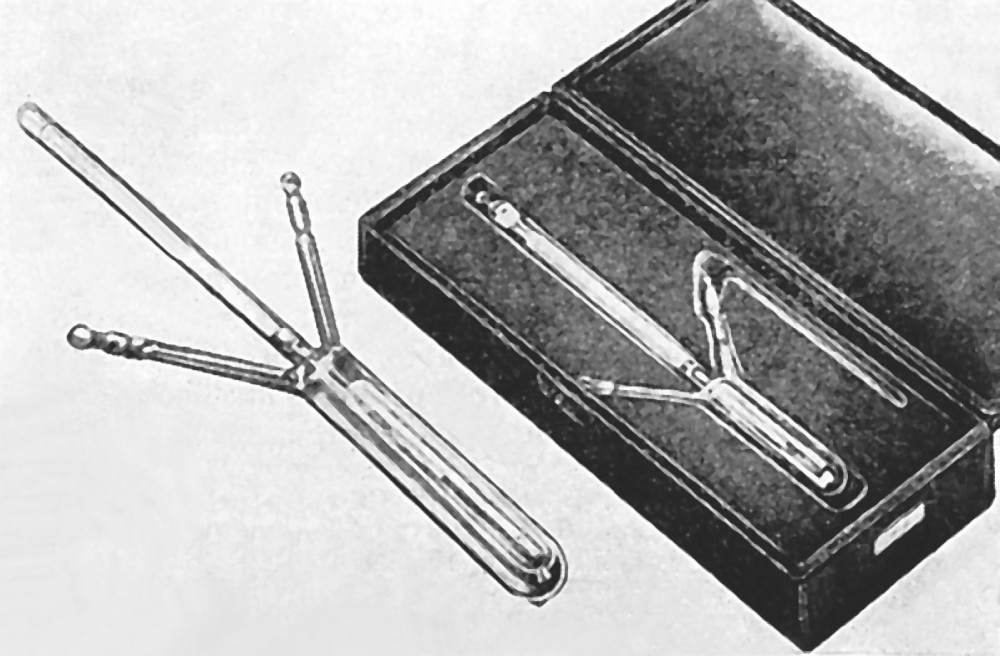
Densimeters constructed by D. I. Mendeleyev. Made in 1859-1860
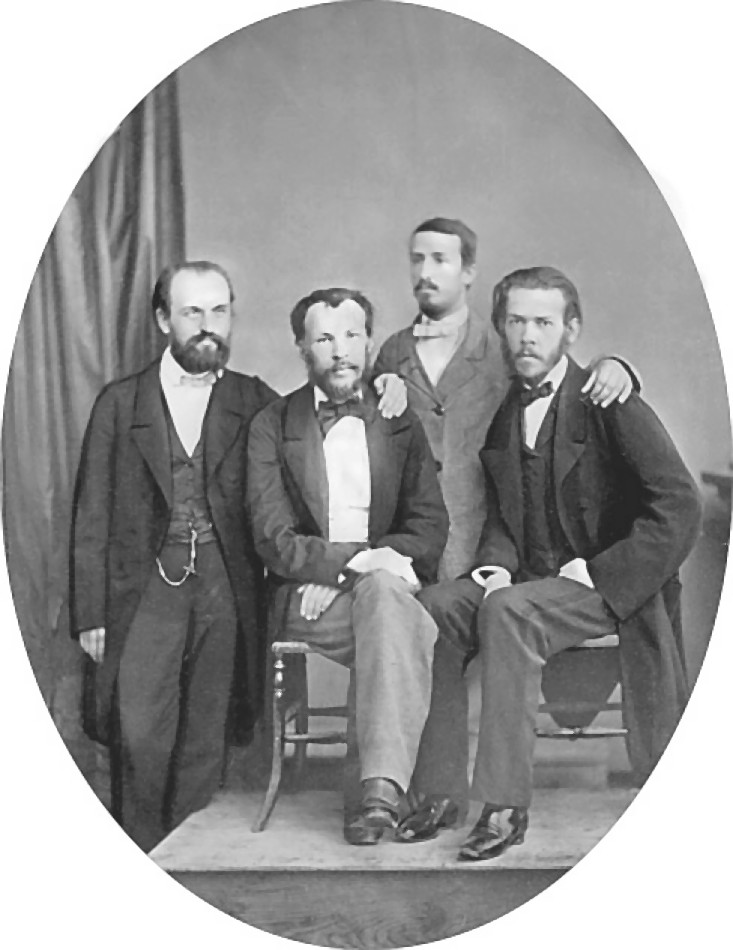
Young Russian scientists-chemists. From left to right: N. Zhitinsky, D. I. Mendeleyev, A. P. Borodin, V. I. Olevinsky, I. O. Heidelberg. 1860
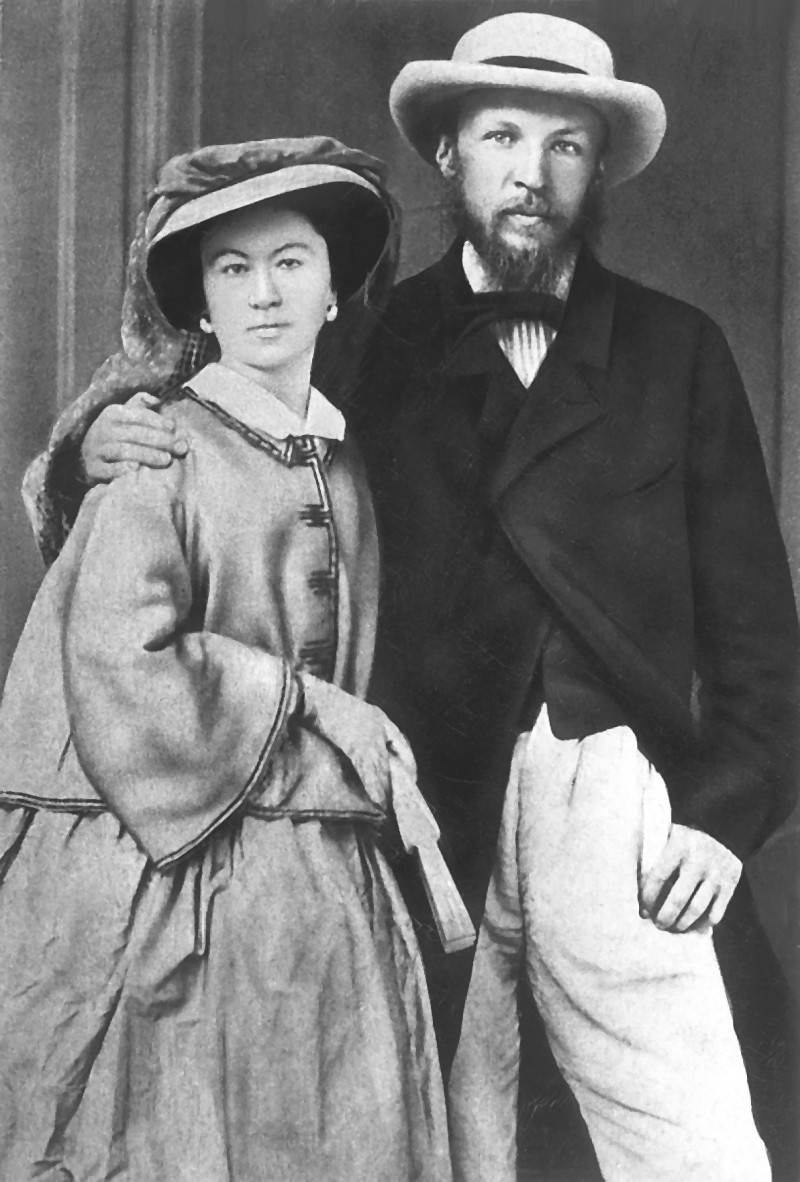
Dmitry Ivanovich Mendeleyev and Theozva Nikitichna Mendeleyeva (nee Leshchova; 1828–1905) – the first wife of D. I. Mendeleyev. 1862
As a result of the research of D. I. Mendeleyev, since the end of the 19th century only product containing grain alcohol mixed by water according to weight exactly till 40°, could have been regarded as Russian (or rather – “Moscow”) vodka. This Mendeleyev’s structure of vodka was patented in 1894 by the government of Russia as Russian national vodka – “Moscow Especial” (first it was named “Moscow Particular”).
As during the life of D. I. Mendeleyev his data were started to be used for the wine-making calculations in Austria, Germany and Holland.
In Imperial Russia the alcoholometrical tables were based on the archaic English and German data. The results of D. I. Mendeleyev were admitted later. In the 1920’s the special commission of the Principle Board of Weights and Measures came to a conclusion that the work of Mendeleyev was precise to the maximum. In 1927 new alcoholometrical tables, the basis of which were the results of the scientist’s research, were published.
From the very graduating the Main Pedagogical Institute, teaching took a considerable time of Dmitry Ivanovich Mendeleyev. Teacher’s work of the scientist amazes by its breadth. At first, together with general, theoretical, organic and analytical chemistry he was teaching physics and physical geography. Students not just loved the scientist, they literally worshipped him. His appearance also made a great impression. He had never delivered his lectures smoothly, but always vividly, interestingly and informally, accompanying his words with an expressive mimicry. It was difficult to take exams to him.
Dmitry Ivanovich was teaching at the University, the Institute of Technology, the Institute of the Corps of Engineers of Communications, at the Nicholas Engineering Academy, the Nicholas Engineering School and at the 2nd Military School. Since 1871 he had been teaching chemistry at the Higher Female Courses. Later the number of the educational institutions, where Mendeleyev had been teaching, slightly reduced and he concentrated all his work mainly at the Institute of Technology and at the University.
Mendeleyev wasn’t only teaching but he always took part in the public life of the educational institutions, quickly reacting to the changes, which had been made in the system of Russian education. The liberal reforms of the 1860’s, which had been made by Alexander II, applied to the system of education in Russia and influenced the life of the University immediately. The statute of the University, signed by Alexander II on June, 18th of 1863, was the most liberal university regulation in Russia of the 19th – the beginning of the 20th century. The statute gave autonomy to the higher educational institution. The University’s board, the members of which were all the professors, became an independent institution. The Board had the right to choose the rector, pro-rector, deans and also professors for the vacant chairs. It was very important that the University’s board got an opportunity to divide the faculties to the branches, to join and to divide the chairs, to change them and to define which subjects should have been considered obligatory and not obligatory for students.
Having become in 1867 the head of the department of general chemistry of the physico-mathematical faculty, Mendeleyev succeeded to separate out an independent course of analytical chemistry, which had been taught by N. A. Menshutkin. Thanks to Mendeleyev’s initiative, A. M. Butlerov was invited to teach the course of organic chemistry from Kazan University in 1868. And since 1869 the chemical sciences were represented at the University by the three departments: of general and inorganic chemistry (D. I. Mendeleyev), of organic chemistry (A. M. Butlerov) and of analytical and technical chemistry (N. A. Menshutkin).
According to the Statute of 1863 the University got the right to establish scientific societies. Thus, Saint-Petersburg Society of Naturalists (1868), the Philological Society (1869) and the Physical Society (1872) appeared.
During these years D. I. Mendeleyev took an active part in the establishment of the scientific chemical society. There are notes in the diaries of the scientist of 1861–1862 about the meetings of the chemists which had become regular. At those meetings there were the majority of well-known chemists and representatives of the adjoining sciences, who worked in Saint-Petersburg. N. N. Zinin, F. F. Beilstein, L. N. Shishkov, A. A. Voskresensky, N. I. Koksharov, E. H. Lenz, B. S. Jacobi, etc. can be mentioned among them. It becomes clear from the diaries to what a great extent was the role of Mendeleyev in the establishment of the scientific chemical society. However, the dream of the scientist was realized only in 1868.
The work at the manual “The fundamentals of chemistry” takes an exclusive place in the life and activities of Dmitry Ivanovich Mendeleyev at the end of the 1860’s. Right this work led the scientist to the discovery of the periodical law of chemical elements. Mendeleyev must have started to work at the text of the manual in winter of 1867–1868, using in the process of the work the stenograms of his lectures, made by the students. The book was published in separate editions, the first of which appeared at the end of May – beginning of June of 1868. Later Dmitry Ivanovich admitted that “The Fundamentals…” was his “dear child.”
During the process of the work at the schedule of the editions of the 2nd part Mendeleyev was gradually coming from grouping the elements according to their valency to their location according to the resemblance of their characteristics and atomic weight. In the middle of February of 1869 Mendeleyev, while keeping thinking over the structure of the subsequent chapters of the book, reached in real earnest the problem of creating the rational system of chemical elements. The determining stage came on February, 17th.

Anna Ivanovna Mendeleyeva (nee Popova; 1860–1942) – the second wife of D. I. Mendeleyev. Late 1870’s

Portrait of D. I. Mendeleyev made by A. I. Mendeleyeva. Oil, 1886
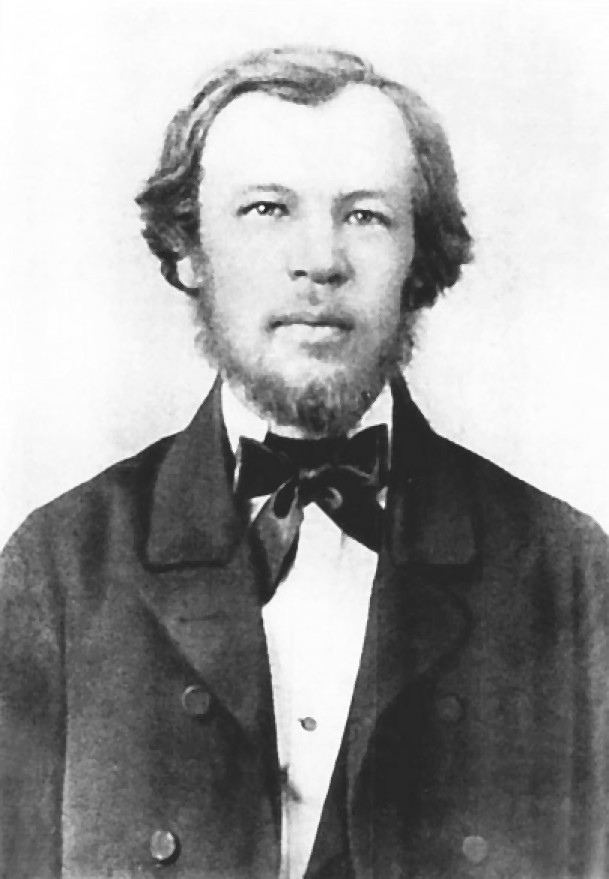
D. I. Mendeleyev. 1861
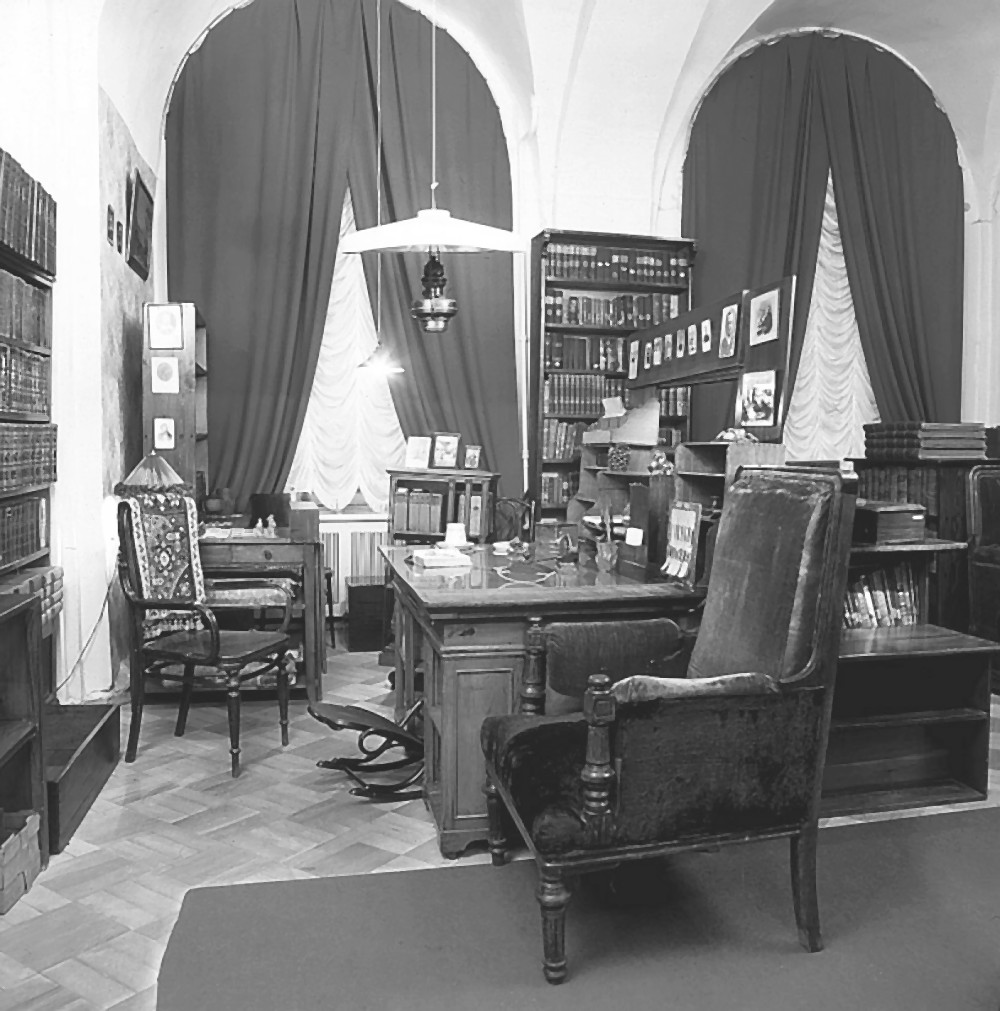
The memorial study of D. I. Mendeleyev. Restored and opened for visitors in December of 1911. (now the D. I. Mendeleyev Museum and Archives attached to SPbSU)
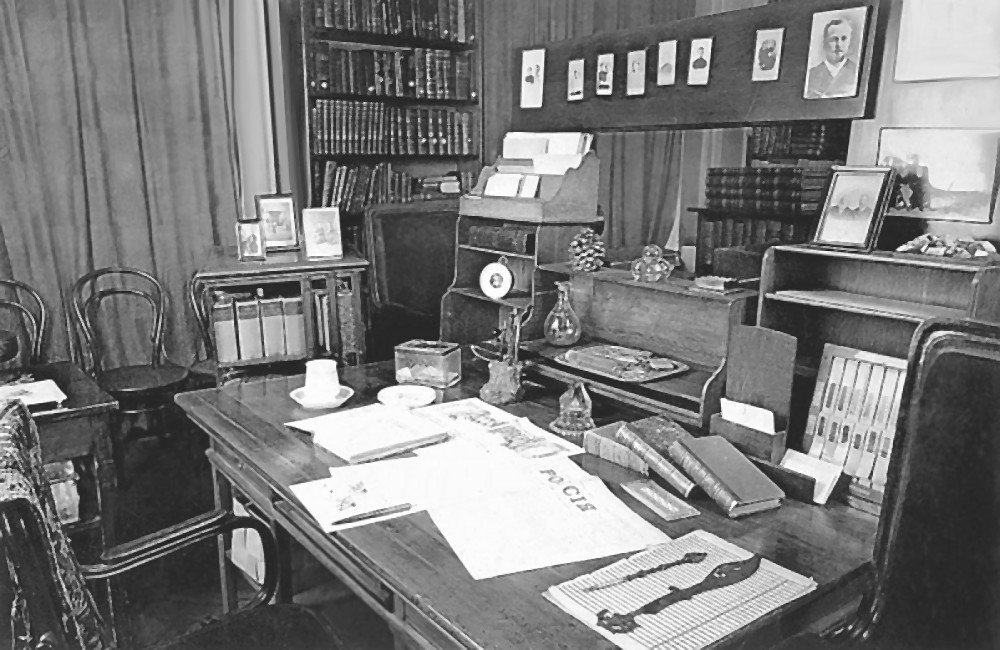
The desktop of D. I. Mendeleyev in his study at the University
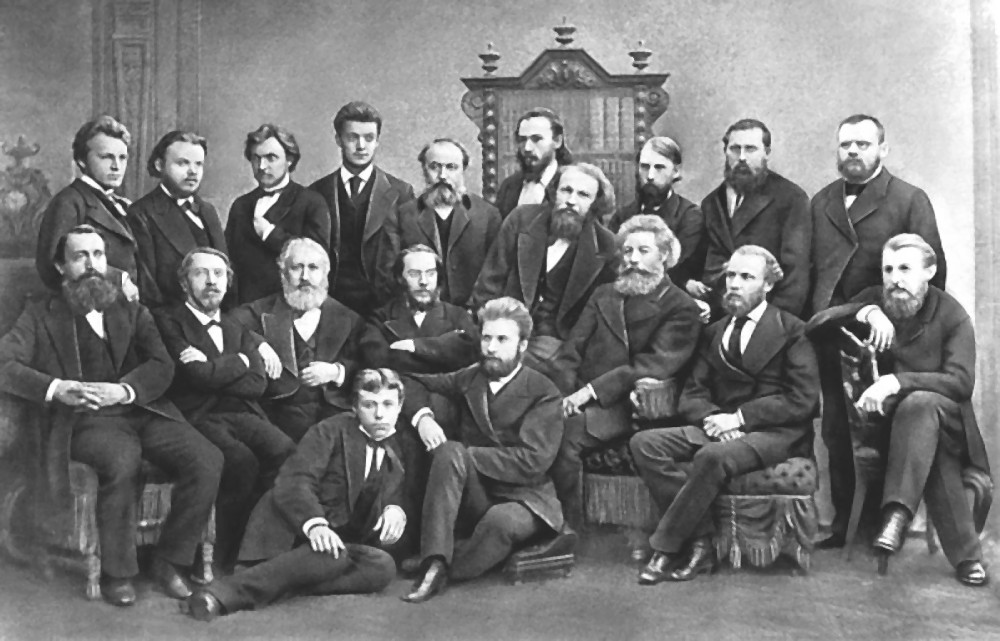
D. I. Mendeleyev (in the centre) among the professors, lecturers and students of the physico-mathematical faculty of Saint-Petersburg University. 1875
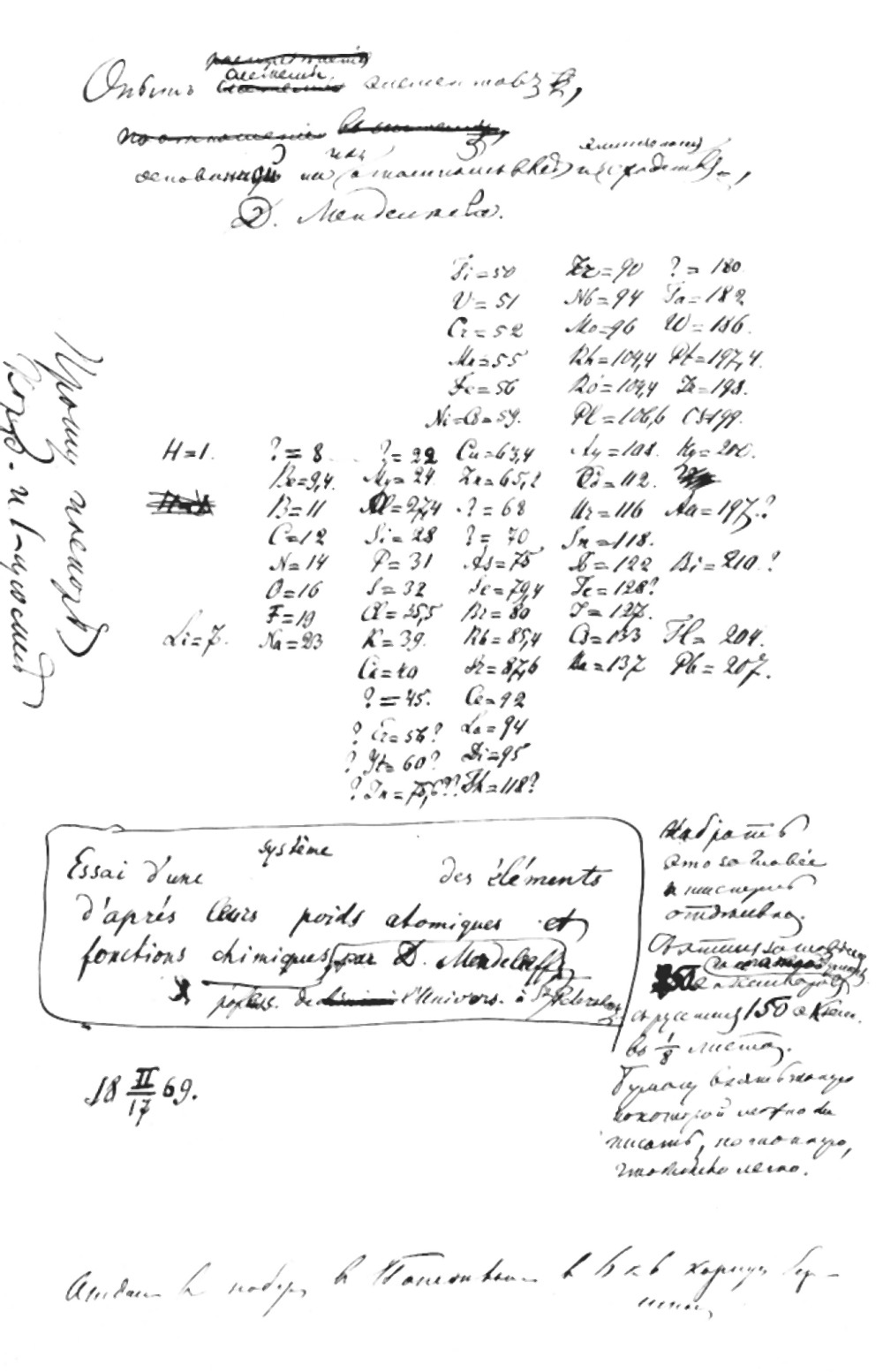
The manuscript of the table “The experience of the system of elements, based on their atomic weight and chemical resemblance.” February, 17 th of 1869
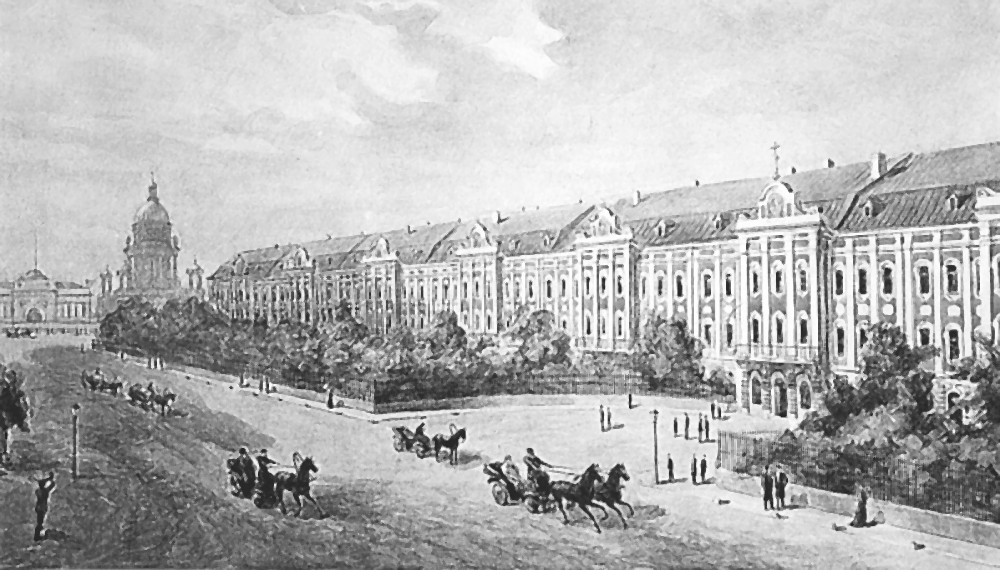
Saint-Petersburg University in the latter half of the 19th century. Water-colour by N. B. Belyavsky after the old engraving. Here D. I. Mendeleyev had been studying at the Main Pedagogical Institute (1850–1855), teaching (1857–1890) and living (1866–1890)
The scientist had been working when in the morning he was given a letter with the information about the supposed urgent trip to Tverskaya province. After having read the letter rapidly, he put the letter aside and kept comparing the different variants of comparing the elements of the natural groups according to their atomic weights. The papers cut into cards finished. A group of columns and lines, which became the starting point of the development of the table “The experience of the system of elements, based on their atomic weights and chemical resemblance”, appeared on the back side of the received letter. During the day Mendeleyev was working over the compilation of “The experience of the system of elements…” In the evening he sent a clean copy of the table to the press having made the notes for the typesetters and having written the date “February, 17th of 1869.”
There is a version that Mendeleyev saw “the system of elements” in his dream. He got up from a joyful excitement and wrote rapidly the table on a piece of paper. That’s all. The scientist compiled a clear and harmonious building of the periodical system from the chaos of separate indigested chemical elements.
Dmitry Ivanovich utterly disliked talking with the strangers “about personal, subjective part of his feelings, about the preparatory period, when the ideas had been formulating and confidence that he had reached the one of the deepest mysteries of nature had been composed little by little.” However, according to the testimonies of Ivan, his son in a second marriage, the scientist used to say that the year of 1860 had become for him the “determinative moment” in the establishment of the periodical system – the congress of chemists in Carlsruhe. And more specifically – the ideas expressed by Italian chemist S. Cannizzaro. D. I. Mendeleyev said, “I consider him to be my real forerunner, because the atomic weights defined by him gave me the necessary point of support.”
In August of 1869, at the Second congress of Russian naturalists the scientist made a report “About the atomic volume of the simple substances”, where he offered a short form of the table. Only In, the rare earth elements and several heavy ones: Au, Hg, Te, Bi, Th, U, didn’t get any place there or were located incorrectly. The scientist kept working at the allocation of these elements.
D. I. Mendeleyev was writing about the 1870’s, “This was a transitional time for me: many things had been changing in me then; I used to read a lot about religions, sects, philosophy and economical articles then.”
At that time the aggressive extremist forces of the society livened up. Mendeleyev showed himself as an active public figure, longing for contributing to the salvation of the social problems of the country. Regarding it the article of the scientist, which had been written by him for the newspaper “Voice” in connection with the appeal of the government to Russian people calling for help in the struggle with extremism, but hadn’t been published, is deserving attention. It was called “Response to the call.” The scientist disputes against the “secret arrangements” of the government – secret investigations, prohibitions to read the “rebellious” literature, etc.
The growth of interest of the scientist to history, philosophy and literature contemporizes with the growth of activity in the socio-political sphere. However, Mendeleyev’s “disposition to painting was coming out clearer than anything else.” According to the testimonies of the contemporaries, he was “not a bad graphic artist.” The Wanderers appeared to be closer to Dmitry Ivanovich than other different art schools. Namely their creativity corresponded with his realistic cast of mind.
Mendeleyev enjoyed travelling very much. During his foreign trips he had studied the main art galleries of the world. It becomes evident at the sight of his photograph albums and engravings. He didn’t miss any art exhibition in Russia. The albums, made by Dmitry Ivanovich during the exhibitions of the painters-Wanderers, are of a special interest. Thus, for instance, in the archive of the scientist there was kept an album of photocopies mainly from the 6th exhibition of 1878.
Since 1878 meetings of painters and scientists, which were named later the “Mendeleyev’s Wednesdays”, started taking place at Mendeleyev’s apartment: “There were constantly present all the Wanderers – Kramskoy, Repin, Yaroshenko, Myasoedov, Kuznetsov, Savitzky, Vl. Makovsky, P. K. Klodt, Maksimov, the Vasnetsovs, Surikov, Shishkin, Quindji, Kiselev, Ostrouhov, Volkov, Pozen, Lemoch, Prahov and Mihaltseva. Among the University professors there were more often than others Beketov, Menshutkin, Petrushevsky, Inostrantsev, Wagner, Voyeikov and Kraevich… They came to the “Wednesdays” without any special invitations.”
The “Wednesdays” were the continuation of those scientists’ meetings, the organization of which had been done by Dmitry Ivanovich during the previous years. Partly the establishment of the Association of the mobile exhibitions became an impulse for organizing the “Wednesdays.”
The scientist was interested in photography and took the most active part in organizing the photographic reproduction of the paintings and in developing the corresponding equipment. At the end of the 1870’s together with some painters and amateurs in photography he organized a group, the goal of which was the “use of photography in spreading the works of Russian art.” The group, which had been gathering at Mendeleyev’s apartment, joined the well-known Russian photographers: S. and L. Levitskies, V. Karrik, the inventor L. Varnerke, the young scientist V. I. Sreznevsky, etc. Namely here the idea of establishing in Petersburg the society of photography was born.
Except photographs and engravings, Dmitry Ivanovich was gathering valuable collections of art originals: drawings of Bruni, Ivanov, Fedotov, Repin, Quindji, Yaroshenko and Shishkin.
The painting of Quindji “Night at the Dnieper” not only made a great impression upon Mendeleyev, but also made him think about the questions of the theory of art. On November, 13th of 1900 in the 314th issue of the “Voice” was published his small article “Before the painting of Quindji.”
Mendeleyev wrote about a certain parallelism of the development of nature sciences and of the interest of artists for scenery: “They started studying nature, the natural science, which hadn’t been known in the ancient times and during the era of the Renaissance, was born… The nature became not a slave, a frame, but a helpmate, equal with man, a wife for a husband… The inductive, experimental sciences using the knowledge of external and internal, reconciling the kingly metaphysics and mathematics with the humble observation and with a request for an answer to the nature, became the crown of knowledge… At the same time with this change in the system of knowledge – if not earlier – the scenery was born.”
Making suitcases and frames for the portraits was another passion of Dmitry Mendeleyev, which became surrounded by legends and rumours. Mendeleyev always bought the materials for the work at Gostiny Dvor. Once, while choosing the necessary goods, he heard somebody asking behind his back: “Who is this respectable gentleman?” And the answer of the clerk: “It is necessary to know such people. This is Mendeleyev, a suitcase-maker.” In general, Mendeleyev liked to paste. It was a rest for him as well as patience or chess. He pasted very neatly and accurately, he sticked on the collections of photographs and engravings of Russian and foreign famous pictures, collected by him, he pasted cases for the albums and brochures, boxes, caskets, small travelling cases. His niece N. Y. Kapustina-Gubkina kept a folding traveling chess-board, made by Dmitry Ivanovich. The pasteboard figures were set into the special squares and they couldn’t fall out of them on no jolting on the road. In 1895 Dmitry Ivanovich couldn’t read and write after having had an operation of the cataract ablation: he had been read the papers aloud, he had been dictating the instructions to his secretary. And till his eyesight hadn’t come back once and for all, Mendeleyev devoted his spare time to this passion, having presented all his friends with suitcases, boxes and caskets.
Mendeleyev paid pretty much attention to the scientific research of spiritualism. He studied the phenomena, happening during the spiritualistic sessions, as a scientist and pedagogue, as far as the passion for spiritualism by many professors of the University could have influenced the student youth. He suggested to establish the special commission for studying the spiritualistic phenomena, attached to the Russian Physical Society. Well-known physicists and chemists took part in it in addition to Dmitry Ivanovich: I. I. Borgman, N. A. Gezehus, N. G. Egorov, K. D. Kraevich, F. F. Petrushevsky, etc. While studying the “spiritualistic phenomena”, the methods of natural sciences, instruments and calculations were broadly used. The conclusions of the commission were joined in the book, published by D. I. Mendeleyev, “The materials for commenting the spiritualism.” The funds, made by selling this book, were meant for “making a big balloon and in general for the research of the meteorological phenomena of the top layers of atmosphere.”
The versatility of personality and variety of interests of Mendeleyev are striking. But the scientist himself used to say so: “I respect one-sided talents, but, nevertheless, I consider them to be a certain abnormality. I like science most of all, but I think that I could have specialized in other spheres under the certain circumstances. I think that a normal person can orient everywhere.”
Mendeleyev was depressed by the end of the 1870’s. The state of his health had become worse. He had been taken ill with pleurisy and he had to go abroad for the treatment. Besides, his relationship with his wife Theozva Nikitichna was cooling down more and more.
In spring of 1877 his wife with the children goes to Boblovo. And the sister of Dmitry Ivanovich Katya comes temporarily with the children to his apartment. Anyuta Popova, the daughter of a Don Cossack, lived as a guest with Nadezhda, the niece of Mendeleyev. She studied at the Conservatoire in the class of piano; she visited the painting school attached to the Academy of Arts. Infatuation of Dmitry Ivanovich for her grew into love. However, Anyuta was more than 20 years younger than Mendeleyev. They were called Faust and Margaret behind their back.
Dmitry Ivanovich suffered deeply while struggling with his feeling. He considered necessary to tell everything to father of Anna Ivanovna, and the last one asked him not to meet with Anyuta anymore. The girl went abroad, but Mendeleyev followed her to Rome. In 1881, after having returned, he wrote to Theozva Nikitichna: “Yesterday I came back to Petersburg with Anna Ivanovna and her father Ivan Eustacievich…
My position is clear and specified already by this. If nothing extraordinary happens, it will stay being like that, and I will stay at the University, I will start lecturing and working as usual, and, in addition, I will solicit to have funds for 2 families.” “We’ve lived, we will stay being friends though not in one house.”
Theozva Nikitichna hasn’t agreed for the divorce for a long time. The marriage was dissolved only in 1881. In winter of the same year Lyuba, the daughter of Anna Ivanovna and Dmitry Ivanovich, was born. They could get married only in 1882. After the wedding the Mendeleyevs settled in the university apartment. Here their younger children were born later: a son Ivan and twins, Maria and Vasiliy, who were called in honour of the mother of Dmitry Ivanovich and his uncle Vasiliy Kornilyev, who had done many things for the Mendeleyevs in his time.
This period was a hard one for D. I. Mendeleyev also by another reason. It seemed to him that he didn’t have enough energy in order to realize his creative potential sufficiently. However, he kept working, and the periodical law, discovered by him, got more and more followers among the scientists of the world.
From the very beginning appeared the question of the priority of the discovery, started by the number of English and German scientists: W. Odling, L. Meyer, etc., in connection with the fundamental importance of the law. Mendeleyev devoted his publication “To the question of the system of elements”, which appeared in the “Reports of German Chemical Society” in 1871, right to this problem. In his small article the scientist mentioned the most important stages of his discovery and suggested for the first time to call his system periodical, because of the periodical law being its basis: “The measurable chemical and physical characteristics of the elements and their connections depend periodically on the atomic weights of the elements.”
The article “The periodical legality of the chemical elements”, which was the result of more than two years of work of the scientist, was published in 1871 in the “Annals of Pharmacy” (“Annalen der Pharmacie”), the oldest chemical magazine, founded in 1832 by the German chemist J. Libich. That is the evaluation of this article by Mendeleyev at the end of the 1890’s:
“This is the best code of my opinions and considerations about the periodicity of elements and this is the original, according to which there was written so much about this system. This is the main reason of my scientific reputation…”
In the same article the scientist gave the criterion of the solidity of the laws of nature in general: “Every law of nature gets the scientific meaning only in case that it, so to say, allows practical consequences, i. e. such logical conclusions, which explain unaccounted and point to the phenomena unknown before, and especially if the law leads to the predictions, which may be checked by experiment. In the last case the meaning of the law is evident and it is possible to check its equity, which at least impulses to the development of the new spheres of the science.”
By applying this thesis to the periodical law, he mentioned the following opportunities of its application: 1) to the system of elements;
2) to the definition of the characteristics of yet unknown elements;
3) to the definition of the atomic weight of scantily explored elements;
4) to the correction of the values of atomic weights; 5) to the renewal of the data concerning the forms of chemical compounds. Besides, Mendeleyev pointed to the possibility of “application of the periodical law: for the correct idea of the so-called associated compounds; for the comparative research of the physical characteristics of simple and compound bodies.” Mendeleyev thought when the physical sense of the periodical law would have been understood and the essence of the elements’ distinction would have been discovered on this basis, “then, certainly, chemistry would be able to leave the hypothetical field of static ideas, which are dominating there nowadays, and then there would be an opportunity to place it under the dynamic direction, which is already applied productively enough to the study of most of the physical phenomena.”
It is possible to say that the scientist outlined by this article the broad programm of the research on the subject of inorganic chemistry, based on the law of periodicity. Indeed, many important directions of inorganic chemistry were developed actually at the end of the 19th – beginning of the 20th century according to the ways, designed by D. I. Mendeleyev.
In March of 1879 there was an important event, which promoted the further consolidation of the periodical law in the science: the Swedish chemist L. Nilson told about having discovered scandium, which appeared to be the same with ekabor of Mendeleyev. However, L. Nilson defined the chemical nature of scandium incorrectly first, holding that the new element should have been placed for certain between tin and thorium in the periodical system. The identity of scandium and ekabor was clearly determined in August of 1879 by the countryman of Nilson P. Kleve. And in 1880 L. Nilson admitted the rightfulness of P. Kleve.
Thus, if the discovery of gallium by P. Lecock de Boibodrant in 1875 only confirmed the opportunities of the periodical system, the discovery of scandium made the chemists look at it as at a strict scientific generalization of data and facts, as to the guide to the further research of chemical elements. In 1884–1887 the periodical law became consolidated and was acknowledged by the vast majority of those scientists, who hadn’t made a proper account of it or ignored it at all.
In 1884 the “problem of beryllium” was finally solved. Up to that moment there hadn’t been any united standpoint concerning the valency of this element and the value of its atomic weight. On April, 17th (5th) L. Nilson wrote a letter to Mendeleyev, where he was stating all the data concerning beryllium and was warmly congratulating him with the fact, “that also in this case, as in many others, the system justified itself.” The discovery of the new chemical element germanium in the rare mineral argyrodite, made by K. Winkler in 1886, became an especially important event of that time in the fortune of the teaching of periodicity.
That was the triumph of the periodical system of elements. It was totally acknowledged by the scientific world. And Mendeleyev himself reacted to the discovery of germanium in a very unusual way: in May of 1886 he made a special photomontage of the “consolidators of the periodical law.” This photomontage, pasted to the mat, consisted of four portraits: P. Lecock de Boibodrant, L. Nilson, K. Winckler and B. Browner. On the back side, in front of each portrait, there were made notes by the hand of Mendeleyev, which were briefly characterizing the accomplishments of the scientist.



